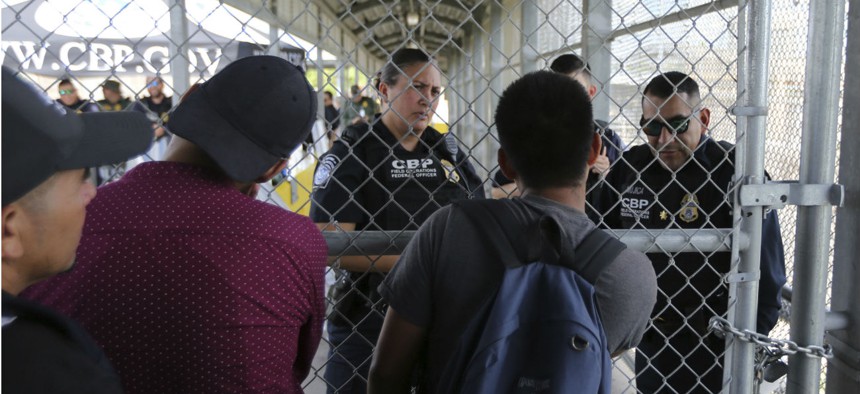
Migrants planning to seek asylum ask Customs and Border Protection officers when the border will re-open, after camping out on the Gateway International Bridge that connects downtown Matamoros, Mexico with Brownsville, Texas. Fernando Llano / AP
Homeland Security Says It Will Dramatically Increase Asylum Workforce by Year's End
The Trump administration has struggled to handle a growing backlog of cases and declining workforce morale.
A component of the Homeland Security Department is hiring hundreds of new employees before the end of the year as it aims to tackle a growing backlog of cases from immigrants seeking legal entry into the country.
U.S. Citizenship and Immigration Services is on pace to hire 500 new employees in its asylum directorate by the end of 2019, the agency said, dramatically increasing the size of that program’s workforce. The hiring surge comes as the number of immigrants currently seeking asylum adjudication has skyrocketed to more than 300,000 cases.
Over the past two years, USCIS has averaged between 500-550 asylum officers. About half of the new hires are expected to be asylum officers themselves, while the rest will be support staff. That would mark a 50% increase for the highly specialized workforce in just a one-year period. The agency said it is developing new strategies to target “individuals with relevant experience and skill sets,” including those who have previously worked in the military and law enforcement.
USCIS has already made a sufficient number of selections to meet its hiring goal by the end of the year, an agency spokesperson said, adding delays in the background check process could lengthen the timeline.
Michael Knowles, special representative of the union council that represents 13,000 USCIS employees, called the hiring a positive step, but said many of the new employees will likely backfill positions left vacant by those who have left the asylum directorate. Knowles, who also serves as an asylum officer, said the stresses of the job typically lead to employees only sticking around for two-to-three years.
“It’s very important and they should’ve been doing it all along,” Knowles said. “They should’ve been much more aggressively filling those vacancies, they should've been much more aggressive in seeking authority for more hiring.”
He added an equally pressing part of the equation is developing strategies to retain employees who have already gone through extensive training and hold expertise in the field. Asylum officers must familiarize themselves with the conditions on the ground in countries around the world, case law and strategies for conducting interviews without intimidating or leading the asylum seekers. Knowles has interviewed asylum seekers from more than 100 countries and estimates it takes at least six months until officers can be trusted to conduct interviews on their own.
As officers constantly hear individuals explain the worst experiences of their lives, work long hours and travel around the country, they often decide after a relatively brief period to find a new line of work within the agency or outside government. Poor morale has been exacerbated by the current administration, which has sought to limit legal immigration and forced employees to comply with policies they say violate federal and international laws.
“How do you deal with burnout, how do you address the crushing workload, how do you make them feel valued when you have an agency head who routinely bashes the program and a president who bashes the program?” Knowles said, suggesting the agency must also answer those questions as it seeks to boost hiring. “Even in the most favorable conditions—under an administration who likes what we do, supports what we do, understands what we do, affirms what we do—we still have high turnover.”
USCIS has also sought to boost asylum processing by deploying Border Patrol agents to conduct interviews determining whether asylum seekers have a “credible fear” of returning to their home countries. That decision has sparked controversy with immigration advocates, who question whether the agency would approach cases with the same mindset and training as asylum experts in USCIS.
Asylum officers have also been deployed to the southern border to process the surge of cases that have piled up in the southwest. USCIS estimated 60-90 were assigned to detention facilities or Border Patrol stations along the U.S.-Mexico border per week in fiscal 2019. Other USCIS employees deployed on a volunteer basis to Border Patrol and Immigration and Customs Enforcement to help conduct operations within the purview of those agencies.
Citizenship and Immigration Services said it is looking to respond to the demands on the ground.
“USCIS continues to prioritize credible fear cases as a result of the ongoing crisis at the border,” the spokesperson said. “USCIS assesses its resources needs on an ongoing basis in light of the credible fear caseload and the affirmative asylum backlog. As these new employees onboard and are trained, that will be considered as part of the staffing assessment.”







